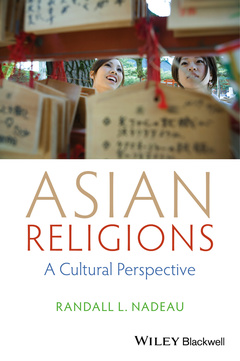Description
Asian Religions
A Cultural Perspective
Author: Nadeau Randall L.
Language: English
Subject for Asian Religions:
Publication date: 01-2014
278 p. · 16x23.6 cm · Hardback
Publication date: 01-2014
288 p. · 15.2x22.6 cm · Paperback
Description
/li>Contents
/li>Biography
/li>
?A unique introduction to Asian religions, combining the scholarly rigor of an established historian of Asian religions with the willingness to engage empathetically with the traditions and to suggest that readers do the same.?
Joseph A. Adler, Kenyon College
?Randall L. Nadeau has accomplished what only a few have tried, but which has been much needed in the study of religions. He has written a genuinely novel approach to the religions of Asia? This is a work that should find its way into Asian humanities, history, religion, and civilization courses.?
Ronnie Littlejohn, Belmont University
This all-embracing introduction to Asian religious practices and beliefs takes a unique approach; not only does it provide a complete overview of the basic tenets of the major Asian religions, but it also demonstrates how Asian spiritualities are lived and practiced, exploring the meaning and significance they hold for believers.
In a series of engaging and lively chapters, the book explores the beliefs and practices of Confucianism, Taoism, Hinduism, Buddhism, and Japanese religions, including Shint?. Using a comparative approach, it highlights the contrasts between Asian and Western modes of thinking and living, and debates the influence of religion on real-world issues including work, economic growth, the environment, human rights, and gender relations.
Nadeau, a leading figure in this field, takes an empathetic approach to Asian religious and cultural traditions, and considers Asian spiritualities to be viable systems of belief for today?s global citizens. Integrating exercises, activities, and an appealing mixture of examples, such as novels and biographies, this refreshing book leads readers to an enhanced understanding of the ideas and practice of Asian religions, and of their continuing relevance today.
List of Figures vii
Preface ix
Part I Introductory Material 1
1 Religion 3
2 Language 11
Part II The Confucian Tradition 19
3 Defining “Religion”: The Confucian Response 21
4 The Religious Dimensions of Confucianism 28
5 The Self as a Center of Relationships 36
6 Learning to Be Human 44
7 The Lasting Influence of Confucianism in Modern East Asia 51
Part III The Taoist Tradition 59
8 What Is Taoism? 61
9 Philosophical Taoism 68
10 Temporal Dimensions of Yin–Yang Cosmology 76
11 Spatial Dimensions of Yin–Yang Cosmology 82
12 Personal Dimensions of Yin–Yang Cosmology 90
13 Taoism as a Global Religious Phenomenon 96
Part IV The Hindu Tradition 103
14 What Is Hinduism? 105
15 Karma-marga 111
16 Jnāna-marga 117
17 Bhakti-marga 123
18 Hinduism in the Modern World 133
Part V The Theravāda Buddhist Tradition 139
19 Buddhism and the Buddha 141
20 Suffering and Its Causes 149
21 Buddhist Ethics 156
22 The Fruits of Meditation 164
23 Monastic Practice 171
Part VI The Mahāyāna Buddhist Tradition 179
24 Faith 181
25 Principles of Zen Buddhism 189
26 Buddhism as a Global Religion 199
Part VII Japanese Religions 207
27 Japanese Religion and Culture 209
28 Shrine Shintō: Dimensions of Sacred Time and Space in Japan 218
29 Dimensions of Religion in Modern Japan 227
Part VIII Conclusions 237
30 “Religion” and the Religions 239
Appendix: Suggestions for Further Reading 246
Glossary 255
Index 260
Randall L. Nadeau is Jennie Farris Railey King Professor of Religion at Trinity University. He has served on the board of the Society for the Study of Chinese Religion, and as chair of the Chinese Religions Group of the American Academy of Religion. He is the editor of The Wiley Blackwell Companion to Chinese Religions (Wiley Blackwell, 2012); author of Confucianism and Taoism, a volume in Introduction to the World’s Major Religions (2009), a six-volume reference work; and numerous published articles on Buddhism, religions of China and Japan, and theory and method in the study of religion.




